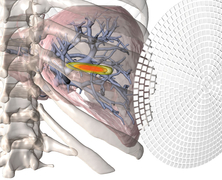Liver therapy with ultrasound

Illustration of numerically simulated high-intensity focused ultrasound therapy.
Tumor removal without a scalpel or x-rays is now possible due to a special type of ultrasound. Strong, concentrated ultrasonic waves are directed at the patient’s body in such a way that they heat and kill individual cancer cells.
A new EU-project wants to transfer this emerging, non-invasive therapy to moving organs, specifically the liver. The Fraunhofer MEVIS Institute for Medical Image Computing Bremen is coordinating “TRANS-FUSIMO”.
At present, the “focused ultrasound (FUS) therapy” is approved for only two diseases – prostate cancer and selected uterine myoma. These can be treated without surgery or exposure to radiation, though liver tumors cannot due to the motion of the organ caused by respiratory movement.
This movement complicates pointing the concentrated ultrasonic wave on the tumor, as the emitted heat spreads over a larger area, inhibiting its desired effect. There is also a higher risk of damaging the surrounding tissue, not achieving the desired therapy outcome. In this case, recurrences of the tumor may occur.
Over the past three years, the scope of the EU funded project, FUSIMO (“Patient Specific Modelling and Simulation of Focused Ultrasound In Moving Organs”, www.fusimo.eu), has laid the foundation for transferring FUS to moving organs.
The first step is to obtain 3D images from magnetic resonance tomography (MRT) that show the inside of the patient’s abdomen and simultaneously register the respiratory movements. Based on this data, experts can perform computer simulations of ultrasound treatment on the liver.
In the simulation, our software computes how the liver moves under respiration and thus can direct the virtual ultrasonic waves in such a way that they follow the movement of the liver and remain focused on the tumor. “In the future, such simulations can enable physicians to plan complex ultrasound interventions individual to the patient and in great detail”, says MEVIS-researcher Jan Strehlow.
“This is especially important in moving organs and can be decisive for indication whether this method of therapy is a viable option for a patient.” Furthermore, computer simulations may help shorten the duration of the ultrasound treatment.
The EU-Project, TRANS-FUSIMO, enables experts to take the next step: they strive to transfer virtual principles into real world applications and develop a system for patient treatment in the clinic. For this, a MR-scanner with a strong ultrasonic transmitter and a regular ultrasonic device are to be combined.
The latter registers the movement of the liver during respiration, in real time, while the patient is in the MR-scanner. Based on this data, the software calculates the path that the strong ultrasonic wave should take in order to stay focused on the tumor in spite of respiratory movement. During the treatment, the MR-scanner measures the distribution of temperature in the abdominal region, which allows physicians to precisely control the ultrasonic rays to target the tumor as desired.
Fraunhofer MEVIS is coordinating this EU-project and developing real-time control of all hardware systems. “Our aim is a product-capable system, for which we seek clinical approval”, says MEVIS-researcher Sabrina Haase. Over the next two years, the technology is to be tested on patients under general anesthesia; their breathing will be artificially halted, so that there is no liver movement for a short period of time. In 2018, the first patients without anesthesia are to be treated while breathing naturally. If these studies yield positive results, the new procedure may be approved.
The Fraunhofer Institute for Medical Image Computing MEVIS
Embedded in a worldwide network of clinical and academic partners, Fraunhofer MEVIS develops real-world software solutions for image-supported early detection, diagnosis, and therapy. Strong focus is placed on cancer as well as diseases of the circulatory system, brain, breast, liver, and lung. The goal is to detect diseases earlier and more reliably, tailor treatments to each individual, and make therapeutic success more measurable. In addition, the institute develops software systems for industrial partners to undertake image-based studies to determine the effectiveness of medicine and contrast agents. To reach its goals, Fraunhofer MEVIS works closely with medical technology and pharmaceutical companies, providing solutions for the entire chain of development from applied research to certified medical products. http://www.mevis.fraunhofer.de/en
TRANS-FUSIMO
TRANS-FUSIMO stands for “Clinical Translation of Patient-Specific Planning and Conducting of FUS Treatment in Moving Organs”. The EU-project was launched in January 2014 and will run for a period of five years with approximately 5.6 mil Euros in funding. Ten institutes from seven countries, including clinics, universities and four medical engineering institutes are participating. The Fraunhofer MEVIS Institute for Medical Image Computing Bremen is coordinating TRANS-FUSIMO.
http://www.trans-fusimo.eu
http://www.mevis.fraunhofer.de/en/news/press-release/article/liver-therapy-with-…
Media Contact
All latest news from the category: Medical Engineering
The development of medical equipment, products and technical procedures is characterized by high research and development costs in a variety of fields related to the study of human medicine.
innovations-report provides informative and stimulating reports and articles on topics ranging from imaging processes, cell and tissue techniques, optical techniques, implants, orthopedic aids, clinical and medical office equipment, dialysis systems and x-ray/radiation monitoring devices to endoscopy, ultrasound, surgical techniques, and dental materials.
Newest articles

Superradiant atoms could push the boundaries of how precisely time can be measured
Superradiant atoms can help us measure time more precisely than ever. In a new study, researchers from the University of Copenhagen present a new method for measuring the time interval,…

Ion thermoelectric conversion devices for near room temperature
The electrode sheet of the thermoelectric device consists of ionic hydrogel, which is sandwiched between the electrodes to form, and the Prussian blue on the electrode undergoes a redox reaction…

Zap Energy achieves 37-million-degree temperatures in a compact device
New publication reports record electron temperatures for a small-scale, sheared-flow-stabilized Z-pinch fusion device. In the nine decades since humans first produced fusion reactions, only a few fusion technologies have demonstrated…





















